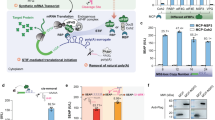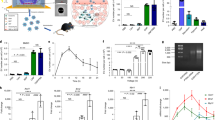Abstract
The ability to overexpress physiologically important proteins in cultured mammalian cells after delivering the encoding mRNAs could have important applications for analyzing their in vivo functions. To explore the potential of this approach, urokinase-type plasminogen activator receptor (uPAR), a membrane protein extensively modified post-translationally, was selected. The uPAR-encoding mRNAs, containing different 5′ and 3′ untranslated regions (UTR) were tested in cultured human osteosarcoma (HOS) cells following a cationic lipid-mediated delivery. The most effective structure was the capped and polyadenylated transcript containing Xenopus β-globin 5′ and 3′ UTRs. Delivering this mRNA to HOS cells resulted in a significant increase of uPAR expression in 89% of the cells, measured by flow cytometry. Using a radioligand binding assay, the increase in functional uPAR levels was found to be up eight- to 11-fold between 8 and 48 h and up three-fold at 72 h after delivery. A similar increase in uPAR levels was achievable in a number of mammalian cell lines. Surprisingly, poly(A)-tailed mRNA leading to a uPAR production highest in magnitude and duration did not demonstrate increased intracellular stability compared with other tested mRNAs. Thus, the exceptional translational performance is not likely the result of an increased mRNA half-life. These results demonstrate that, after delivery of selected mRNAs into mammalian cells, immediate and significant overexpression of a post-translationally modified protein is achievable.
This is a preview of subscription content, access via your institution
Access options
Subscribe to this journal
Receive 12 print issues and online access
$259.00 per year
only $21.58 per issue
Buy this article
- Purchase on Springer Link
- Instant access to full article PDF
Prices may be subject to local taxes which are calculated during checkout








Similar content being viewed by others
References
Dear AE, Medcalf RL . The urokinase-type-plasminogen-activator receptor (CD87) is a pleiotropic molecule Eur J Biochem 1998 252: 185–193
Karikó K et al. Overexpression of urokinase receptor increases matrix invasion without altering cell migration in a human osteosarcoma cell line Cancer Res 1993 53: 3109–3117
Huez G, Bruck C, Cleuter Y . Translational stability of native and deadenylated rabbit globin mRNA injected into HeLa cells Proc Natl Acad Sci USA 1981 78: 908–911
Drummond DR, Armstrong J, Colman A . The effect of capping and polyadenylation on the stability, movement and translation of synthetic messenger RNAs in Xenopus oocytes Nucleic Acids Res 1985 13: 7375–7394
Bechler K . Influence of capping and polyadenylation on mRNA expression and antisense RNA mediated inhibition of gene expression Biochem Biophys Res Comm 1997 241: 193–197
Callis J, Fromm M, Walbot V . Expression of mRNA electroporated into plant and animal cells Nucleic Acids Res 1987 15: 5823–5831
Gallie DR . The cap and poly(A) tail function synergistically to regulate mRNA translational efficiency Genes Dev 1991 5: 2108–2116
Gallie DR, Tanguay RL, Leathers V . The tobacco etch viral 5′ leader and poly(A) tail are functionally synergistic regulators of translation Gene 1995 165: 233–238
Gallie DR, Lewis NJ, Marzluff WF . The histone 3′-terminal stem-loop is necessary for translation in Chinese hamster ovary cells Nucleic Acids Res 1996 24: 1954–1962
Tanguay RL, Gallie DR . Translational efficiency is regulated by the length of the 3′ untranslated region Mol Cell Biol 1996 16: 146–156
Hambidge SJ, Sarnow P . Terminal 7-methyl-guanosine cap structure on the normally uncapped 5′ noncoding region of poliovirus mRNA inhibits its translation in mammalian cells J Virol 1991 65: 6312–6315
Mathiasen JR et al. Increased vasopressin secretion from hypothalamic cultures following administration of exogenous vasopressin mRNA Exp Neurol 1996 141: 165–172
Malone RW, Felgner PL, Verma IM . Cationic liposome-mediated RNA transfection Proc Natl Acad Sci USA 1989 86: 6077–6081
Lu D et al. Optimization of methods to achieve mRNA-mediated transfection of tumor cells in vitro and in vivo employing cationic liposome vectors Cancer Gene Ther 1995 1: 245–252
Dwarki VJ, Malone RW, Verma IM . Cationic liposome-mediated RNA transfection Meth Enzymol 1994 217: 644–654
Karikó K et al. Phosphate-enhanced transfection of cationic lipid-complexed mRNA and plasmid DNA Biochim Biophys Acta 1998 1369: 320–334
Gurdon JB, Lingrel JB, Marbaix G . Message stability in injected frog oocytes: long life of mammalian α and β globin messages J Mol Biol 1973 80: 539–551
Jang SK et al. Initiation of protein synthesis by internal entry of ribosomes into the 5′ nontranslated region of encephalomyocarditis virus RNA in vivo J Virol 1989 63: 1651–1660
Borman AM et al. Picornavirus internal ribosome entry segments: comparison of translation efficiency and the requirements for optimal internal initiation of translation in vitro Nucleic Acids Res 1995 23: 3656–3663
Svitkin YV et al. General RNA binding proteins render translation cap dependent EMBO J 1996 15: 7147–7155
Kabnick KS, Housman DE . Determinants that contribute to cytoplasmic stability of human c-fos and β-globin mRNA are localized at several site in each mRNA Mol Cell Biol 1988 8: 3244–3250
Wolff JA et al. Direct gene transfer into mouse muscle in vivo Science 1990 247: 1465–1468
Conry RM et al. Characterization of a messenger RNA polynucleotide vaccine vector Cancer Res 1995 55: 1397–1400
Strong TV et al. Incorporation of β-globin untranslated regions into a Sindbis virus vector for augmentation of heterologous mRNA expression Gene Therapy 1997 4: 624–627
Shimotohno K et al. Importance of 5′-terminal blocking structure to stabilize mRNA in eukaryotic protein synthesis Proc Natl Acad Sci USA 1977 74: 2734–2738
Furuichi Y, La Fiandra A, Shatkin AJ . 5′-Terminal structure and mRNA stability Nature 1977 266: 235–239
Coutts M, Brawerman G . A 5′ exoribonuclease from cytoplasmic extracts of mouse sarcoma 180 ascites cells Biochim Biophys Acta 1993 1173: 57–62
Jacobson A, Favreau M . Possible involvement of poly(A) in protein synthesis Nucleic Acids Res 1983 11: 6353–6368
Shetty A, Kumar A, Idell S . Posttranscriptional regulation of urokinase receptor mRNA: identification of a novel urokinase receptor mRNA binding protein in human mesothelioma cells Mol Cell Biol 1997 17: 1075–1083
Peng SS-Y et al. RNA stabilization by the AU-rich element binding protein, HuR, an ELAV protein EMBO J 1998 17: 3461–3470
Johanning FW et al. A sindbis virus mRNA polynucleotide vector achieves prolonged and high level heterologous gene expression in vivo Nucleic Acids Res 1995 23: 1495–1501
Jirikowski GF et al. Reversal of diabetes insipidus in Brattleboro rats: intrahypothalamic injection of vasopressin mRNA Science 1992 255: 996–998
Maciejewski-Lenoir D et al. Reduction of exogenous vasopressin RNA poly(A) tail length increases its effectiveness in transiently correcting diabetes insipidus in Brattleboro rat Proc Natl Acad Sci USA 1993 90: 1435–1439
Mellits KH et al. Removal of double-stranded contaminants from mRNA transcripts: synthesis of adenovirus VA RNAI from a T7 vector Nucleic Acids Res 1990 18: 5401–5406
Hovanessian AG, Galabru J . The double-stranded RNA-dependent protein kinase is also activated by heparin Eur J Biochem 1987 167: 467–473
Kaufman RJ et al. The phosphorylation state of eucaryotic initiation factor 2 alters translational efficiency of specific mRNAs Mol Cell Biol 1989 9: 946–958
Karikó K et al. Lipofectin-aided cell delivery of ribozyme targeted to human urokinase receptor mRNA FEBS Lett 1994 352: 41–44
Barnathan ES et al. Interaction of single chain urokinase-type plasminogen activator with human endothelial cells J Biol Chem 1990 265: 2865–2872
Chomczynski P, Sacchi N . Single-step method of RNA isolation by acid guanidinium thiocyanate-phenol-chloroform extraction Anal Biochem 1987 162: 156–159
England TE, Uhlenbeck O . 3′-Terminal labelling of RNA with T4 RNA ligase Nature 1978 275: 560–561
Acknowledgements
We thank Dr Krieg for the pT7TS and Dr Gallie for the pT7-TEV-luc-A50 plasmids, Dr Henkin for scuPA and Dr Collman for 293T cells. This work was supported in part by funding from the Department of Neurosurgery, University of Pennsylvania, and by grants from the NIH (HL47839). We thank Dr Qi Xiao for her assistance in generating the pCITE-uPAR.
Author information
Authors and Affiliations
Rights and permissions
About this article
Cite this article
Karikó, K., Kuo, A. & Barnathan, E. Overexpression of urokinase receptor in mammalian cells following administration of the in vitro transcribed encoding mRNA. Gene Ther 6, 1092–1100 (1999). https://doi.org/10.1038/sj.gt.3300930
Received:
Accepted:
Published:
Issue Date:
DOI: https://doi.org/10.1038/sj.gt.3300930
Keywords
This article is cited by
-
Innovation in the 21st century: following the footsteps of Katalin Karikó
Biologia Futura (2023)
-
Recent advances in mRNA-LNP therapeutics: immunological and pharmacological aspects
Journal of Nanobiotechnology (2022)
-
Base-editing-mediated dissection of a γ-globin cis-regulatory element for the therapeutic reactivation of fetal hemoglobin expression
Nature Communications (2022)
-
The tangled history of mRNA vaccines
Nature (2021)
-
Evaluation of modified Interferon alpha mRNA constructs for the treatment of non-melanoma skin cancer
Scientific Reports (2018)



